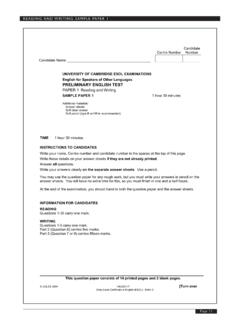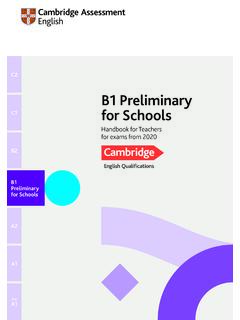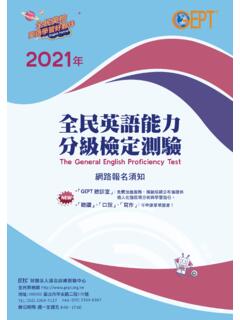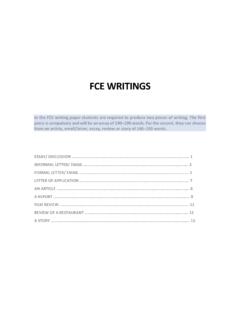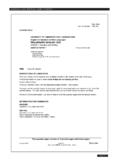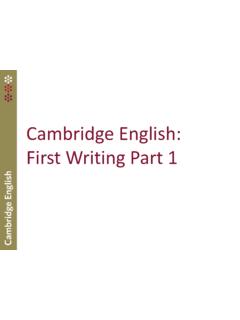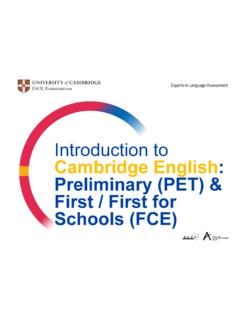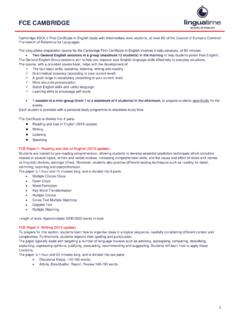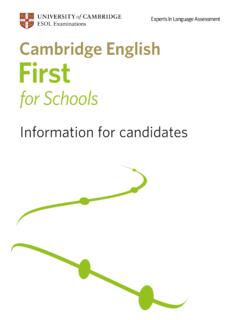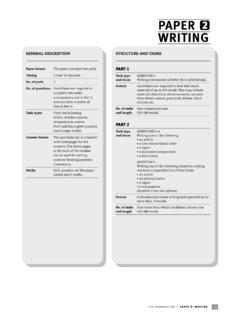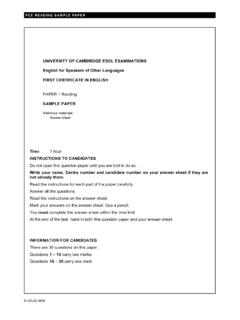Transcription of Handbook for Teachers - 國立臺灣大學
1 Handbook for TeachersContent and overviewPaper/timingContentTest focus1 REading1 hour Part 1A text followed by eight multiple-choice are expected to show understanding of specific information, text organisation features, tone, and text 2A text from which seven sentences have been removed and placed in a jumbled order, together with an additional sentence, after the 3A text or several short texts preceded by 15 multiple-matching questions. 2 WRiTing1 hour 20 minutesPart 1 One compulsory are expected to be able to write non-specialised text types such as an article, an essay, a letter, an email, a report, a review, or a short story, with a focus on advising, apologising, comparing, describing, explaining, expressing opinions, recommending, 2 Candidates choose one task from a choice of five questions (including the set text options).
2 3 USE OF EngLiSH45 minutesPart 1A modified cloze test containing 12 gaps and followed by 12 multiple-choice are expected to demonstrate the ability to apply their knowledge of the language system by completing a number of 2A modified open cloze test containing 12 3A text containing 10 gaps. Each gap corresponds to a word. The stems of the missing words are given beside the text and must be changed to form the missing 4 Eight separate questions, each with a lead-in sentence and a gapped second sentence to be completed in two to five words, one of which is a given key word .4 LiSTEningApproximately 40 minutesPart 1A series of eight short unrelated extracts from monologues or exchanges between interacting speakers. There is one multiple-choice question per are expected to be able to show understanding of attitude, detail, function, genre, gist, main idea, opinion, place, purpose, situation, specific information, relationship, topic, agreement 2A monologue or text involving interacting speakers, with a sentence completion task which has 10 3 Five short related monologues, with five multiple-matching 4A monologue or text involving interacting speakers, with seven multiple-choice questions.
3 5 SPEaKing14 minutesPart 1A conversation between the interlocutor and each candidate (spoken questions).Candidates are expected to be able to respond to questions and to interact in conversational 2An individual long turn for each candidate, with a brief response from the second candidate (visual and written stimuli, with spoken instructions).Part 3A two-way conversation between the candidates (visual and written stimuli, with spoken instructions).Part 4A discussion on topics related to Part 3 (spoken questions).1 CAMBRIDGE english : first Handbook FOR TEACHERSCONTENTSP refaceThis Handbook is for Teachers who are preparing candidates for Cambridge english : first , also known as first certificate in english (FCE). The introduction gives an overview of the exam and its place within Cambridge ESOL.
4 This is followed by a focus on each paper and includes content, advice on preparation and example you need further copies of this Handbook , please email Cambridge ESOL 2 The world s most valuable range of english qualifications 2 Key features of Cambridge english exams 2 Proven quality 2 Introduction to Cambridge english : first 3 Who is the exam for? 3 Who recognises the exam?
5 3 What level is the exam? 3 Exam content and processing 3A thorough test of all areas of language ability 3 International english 4 Marks and results 4 Certificates 4 Exam support 4 Support
6 For Teachers 4 Support for candidates 5 paper 1 Reading 7 General description 7 Structure and tasks 7 The three parts of the Reading paper 8 Preparation 8 Sample paper 10 Answer key 13 Candidate answer sheet 13 paper 2 writing 14 General description 14 Structure and tasks 14 The two parts of the writing paper 15 Preparation
7 16 Sample paper 18 Assessment of writing 20 Sample scripts with examiner comments 24 paper 3 Use of english 30 General description 30 Structure and tasks 30 The four parts of the Use of english paper 31 Preparation 31 Sample paper 34 Answer key 37 Candidate answer sheet 38 paper 4 Listening 39 General description 39 Structure and tasks
8 39 The four parts of the Listening paper 40 Preparation 40 Sample paper 42 Answer key 49 Candidate answer sheet 50 paper 5 Speaking 51 General description 51 Structure and tasks 51 The four parts of the Speaking test 52 Preparation 52 Sample paper 55 Assessment of Speaking 58 Cambridge english : first glossary 63 Contents2 CAMBRIDGE english .
9 first Handbook FOR TEACHERSABOUT CAMBRIDGE ESOLA bout Cambridge ESOLC ambridge english : first is developed by University of Cambridge ESOL Examinations (Cambridge ESOL), a not-for-profit department of the University of ESOL is one of three major exam boards which form the Cambridge Assessment Group (Cambridge Assessment). More than 8 million Cambridge Assessment exams are taken in over 160 countries around the world every world s most valuable range of english qualificationsCambridge ESOL offers the world s leading range of qualifications for learners and Teachers of english . Over million people take our exams each year in 130 countries. Cambridge ESOL offers assessments across the full spectrum of language ability. We provide examinations for general communication, for professional and academic purposes, and also specialist legal and financial english qualifications.
10 All of our exams are aligned to the principles and approach of the Common European Framework of Reference for Languages (CEFR). To find out more about Cambridge english exams and the CEFR, go to addition to our own programmes of world-leading research, we work closely with professional bodies, industry professionals and governments to ensure that our exams remain fair and relevant to candidates of all backgrounds and to a wide range of stakeholders. Key features of Cambridge english examsCambridge english exams: are based on realistic tasks and situations so that preparing for their exam gives learners real-life language skills accurately and consistently test all four language skills reading, writing , listening and speaking as well as knowledge of language structure and its use encourage positive learning experiences, and seek to achieve a positive impact on teaching wherever possible are as fair as possible to all candidates, whatever their national, ethnic and linguistic background, gender or qualityCambridge ESOL s commitment to providing exams of the highest possible quality is underpinned by an extensive programme of research and evaluation, and by continuous monitoring of the marking and grading of all Cambridge english exams.
